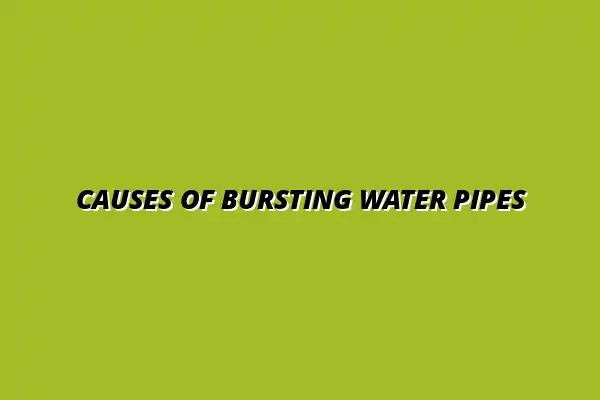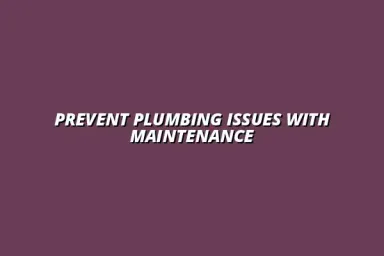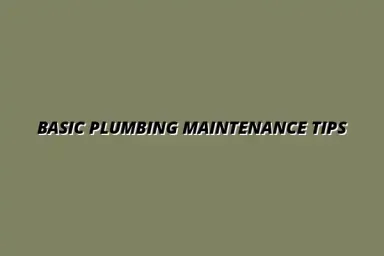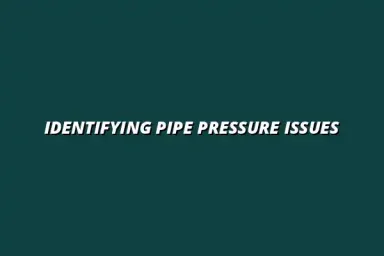Understanding the Impact of Cold Weather on Water Pipes
As winter approaches, it's essential to understand how cold weather affects water pipes. When temperatures drop, the risk of pipe bursting increases significantly. This can lead to costly repairs and serious water damage in your home. In this article, we'll explore the science behind these issues and how to prevent them.
Many homeowners, like those of us at Plumb Pro Care, are often unaware of the underlying factors that contribute to pipe damage during the colder months. By understanding how temperature affects water pipe integrity, you can take proactive steps to safeguard your plumbing system.
How Temperature Affects Water Pipe Integrity
The temperature of the surrounding environment directly impacts the integrity of your water pipes. When temperatures fall below freezing, the water inside the pipes can freeze, expanding as it does so. This expansion can exert pressure on the pipe material, leading to cracks and, ultimately, bursts.
Moreover, pipes that are not well-insulated are particularly at risk. Homeowners might notice that pipes in unheated areas, such as basements or crawl spaces, are more susceptible to damage. It's crucial to pay attention to these areas to prevent expensive repairs!
- Check insulation around exposed pipes.
- Seal any drafts in unheated areas.
- Consider heating cables for extremely vulnerable pipes.
The Science Behind Pipe Bursting in Low Temperatures
Pipe bursting, especially in low temperatures, is a complex phenomenon. When water freezes, it expands by about 9%. This significant increase can create immense pressure within the pipes, leading to bursts. Understanding this science helps homeowners recognize the importance of preventive measures.
It's not just the freezing temperatures that you need to worry about, but also how long those temperatures persist. Longer cold spells can amplify the risk of damage, making it vital to stay vigilant during harsh winters.
Material Composition and Its Role in Cold Resistance
Different pipe materials react uniquely to cold temperatures. For instance, copper pipes are less prone to bursting than PVC pipes in freezing conditions. Knowing your pipes' material can help you better prepare for winter hazards.
When selecting plumbing materials, it's essential to consider your local climate. At Plumb Pro Care, we often recommend materials that can withstand the winter weather in Birmingham to ensure the longevity of your plumbing system. Here are some common materials:
- Copper: Durable but more expensive.
- PVC: Affordable but vulnerable to freezing.
- PEX: Flexible and resistant to freezing but requires proper installation.
Identifying Common Causes of Pipe Bursting in Winter
Understanding common causes can help you take preventative measures to avoid pipe bursting during winter months. The most significant factor is the freezing of water, but there are other elements at play as well.
Let's dive into the physical principles that govern how cold weather can lead to pipe damage. By being informed, you can make better choices regarding your home's plumbing system!
Freezing Water Expands: Understanding the Physics
As we've mentioned, when water freezes, it expands. This can create pressure on your pipes, especially if the pipes are already under strain. The physics behind this phenomenon is straightforward but vital for homeowners to understand.
When water turns into ice, it can push against the walls of your pipes. If the pressure becomes too great, the pipes can crack or burst, leading to potential flooding. Always ensure that your pipes are well-insulated to mitigate this risk!
- Monitor water lock locations during cold snaps.
- Keep a trickle of water running during extreme cold.
- Insulate pipes that run through unheated spaces.
The Role of Ice Formation in Pipe Damage
Ice formation can lead to significant problems in plumbing systems. Ice can create blockages, leading to increased pressure on your pipes, which can ultimately result in bursting. Homeowners should be cautious and regularly check for signs of ice buildup.
In areas where ice formation is common, like unheated attics or basements, extra vigilance is needed. At Plumb Pro Care, we always encourage our clients to prepare for winter with a thorough plumbing inspection.
Why Certain Pipes Are More Vulnerable in Cold Weather
Not all pipes are created equal when it comes to withstanding cold temperatures. Some materials are inherently more vulnerable than others, making it crucial to understand what you have in your home. For example, metal pipes may conduct cold and heat differently than plastic ones.
By choosing the right materials and taking precautions, like adding insulation where needed, you can significantly reduce the chances of issues arising during winter. It's always a good idea to consult with professionals to ensure you have durable pipes for your area!
Evaluating the Long-Term Impact of Winter on Water Pipes
As winter approaches, it's crucial to consider the long-term effects that cold weather can have on your water pipes. When problems are left unaddressed, the risks escalate significantly. Not only can these issues lead to costly repairs, but they can also create potential hazards within your home.
Ignoring pipe problems can result in **potential flooding** and extensive water damage. This can compromise the structural integrity of your home, making it imperative to address any signs of trouble before they escalate. Additionally, ongoing leaks can foster mold growth, leading to health issues for you and your family.
- Possible mold growth
- Damage to floors and walls
- Damage to electrical systems
Understanding the Risks of Unaddressed Pipe Issues
It’s not just about the immediate inconvenience of a burst pipe; the *financial implications* can be staggering. Homeowners often face costly repairs and can even see their insurance premiums rise after a major claim. Keeping an eye on your plumbing can save you from unexpected expenses.
In addition to repair costs, consider potential disruptions to your daily life. After a pipe bursts, you might need to find temporary housing or deal with extensive home repairs, which can be both stressful and inconvenient. This is why proactive measures are essential.
- Average cost of pipe repairs
- Insurance implications
- Impact on home value
Final Thoughts on Protecting Your Plumbing System
Creating a cold weather maintenance plan is a sensible step every homeowner should consider. This plan can help you identify areas of concern and take action before the worst happens. I recommend reviewing your plumbing system regularly, especially before winter hits.
A comprehensive checklist can help keep you organized. This should include items like checking for insulation, monitoring temperatures, and scheduling regular inspections. Remember, staying ahead of potential issues can save you time, stress, and money!
- Check insulation around pipes
- Inspect exterior faucets
- Schedule annual plumbing inspections
Encouraging Proactive Steps for Homeowners
Community awareness is essential when it comes to plumbing issues. Share resources with neighbors and friends about the importance of plumbing maintenance in winter. Together, we can foster a community that prioritizes proactive measures to protect homes from the cold.
Don't hesitate to engage with local experts for reliable guidance. As a plumbing service dedicated to helping our community, we often recommend consulting with professionals to tailor solutions to your specific plumbing needs. Being proactive today can help ensure a safe and functional plumbing system this winter!
- Local plumbing workshops
- Community forums on home maintenance
- Referral programs for plumbing services

 Kiran Almasi
Kiran Almasi

